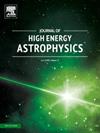Effect of turbulence on blazar variability - II: Stochastic variability within leptonic scenario
IF 10.2
4区 物理与天体物理
Q1 ASTRONOMY & ASTROPHYSICS
引用次数: 0
Abstract
Understanding the origin of the long-term stochastic variability of blazars in different wavebands is a decade-long problem. In this work, we investigate the stochastic variability of blazar emission within the framework of a time-dependent one-zone leptonic model. This model considers the acceleration of the relativistic electrons present in the blazar jet by both the Fermi first order and second order acceleration process, along with radiative energy loss of the same electrons and diffusive escape of those electrons from the acceleration/emission zone. The effect of second order Fermi acceleration is incorporated in the present model through momentum diffusion coefficient considering random scattering of the relativistic electrons by magneto-hydrodynamic (MHD) turbulence. We simulate the variability in the multi-wavelength photon light curves by introducing stochastic variation in the electron injection. Then estimated the power spectral density, probability density function and rms-flux relation to quantify the variability. Here, we show that for different types of stochastic injection process, the nature of the variability changes. The variability properties also depend on the nature of the MHD turbulence present in the system.
湍流对耀变体的影响- II:轻子情景下的随机变率
了解耀变体在不同波段的长期随机变化的起源是一个长达十年的问题。在这项工作中,我们在一个随时间变化的单区轻子模型的框架内研究了耀变体发射的随机变异性。该模型考虑了费米一阶和二阶加速过程中存在于耀焰喷流中的相对论性电子的加速,以及相同电子的辐射能量损失和这些电子从加速/发射区扩散逃逸。通过动量扩散系数考虑相对论性电子在磁流体湍流中的随机散射,将二阶费米加速度的影响纳入模型。我们通过引入电子注入的随机变化来模拟多波长光子光曲线的变化。然后估计功率谱密度、概率密度函数和均方根通量关系来量化变异。本文表明,对于不同类型的随机注入过程,变异性的性质是不同的。变率特性还取决于系统中存在的MHD湍流的性质。
本文章由计算机程序翻译,如有差异,请以英文原文为准。
求助全文
约1分钟内获得全文
求助全文
来源期刊

Journal of High Energy Astrophysics
Earth and Planetary Sciences-Space and Planetary Science
CiteScore
9.70
自引率
5.30%
发文量
38
审稿时长
65 days
期刊介绍:
The journal welcomes manuscripts on theoretical models, simulations, and observations of highly energetic astrophysical objects both in our Galaxy and beyond. Among those, black holes at all scales, neutron stars, pulsars and their nebula, binaries, novae and supernovae, their remnants, active galaxies, and clusters are just a few examples. The journal will consider research across the whole electromagnetic spectrum, as well as research using various messengers, such as gravitational waves or neutrinos. Effects of high-energy phenomena on cosmology and star-formation, results from dedicated surveys expanding the knowledge of extreme environments, and astrophysical implications of dark matter are also welcomed topics.
 求助内容:
求助内容: 应助结果提醒方式:
应助结果提醒方式:


